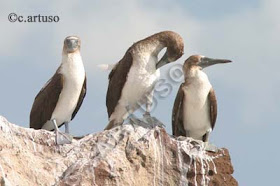The first installment starts basically at seal level. The coastline itself is not homogeneous, rather there are wetlands and marshy areas rich with waterbirds like these Roseate Spoonbills, Black-necked Stilt, Snowy Egret, and Little Blue Heron…

There are also sandy beaches with numerous wintering shorebirds such as this Wilson’s Plover. This bird was feeding along the shore where a stream trickled down to the beach. This species has an unusually long and heavy bill for a plover.

Interspersed between the sandy beaches and other habitats are rocky coastal areas where we found this striking American Oystercatcher

The very large Royal Terns are common along many areas of coastline

And where there are rocky outcrops just offshore you may find boobies such as these Blue-footed Boobies. This appears to be a family relaxing together (juvenile middle). Note the characteristic fully webbed feet. If you're looking at the feet you may notice that the youngster is banded.

This is a Brown Booby. The sulids (boobies and gannets) are well known for their remarkable diving ability (plunging beak first into the water from considerable heights) and their long pointed bills are well suited to fishing.

Magnificent Frigatebirds can be common on both coasts depending on time of year. This is a young bird with the all white head, probably second year. The frigatebirds have such a distinctive shape that they are identifiable to family/genus (there is only one genus in the family and just 5 species) at a very long distance. Where two or more species overlap identification to species level is much more difficult. Their unique wings give them exceptional speed over the open ocean and they sometimes torment other birds into dropping their catch, earning them nickname “pirates” or “man-of-war birds”.

The Red-billed Tropicbird is unlikely to be seen from shore so we organized a boat trip out from San Blas to an outcrop known as “Roca Elefante” where they breed. Here we were rewarded with fantastic looks. Tropicbirds represented a family I had never seen before (Phaethontidae). These "ribijuncos", as they are elegantly called in Spanish, seemed to nest only very high on the rock and shot in and out of their burrows so we never saw them perched, but they were certainly spectacular in the air with their elegant tail streamers.



No comments:
Post a Comment